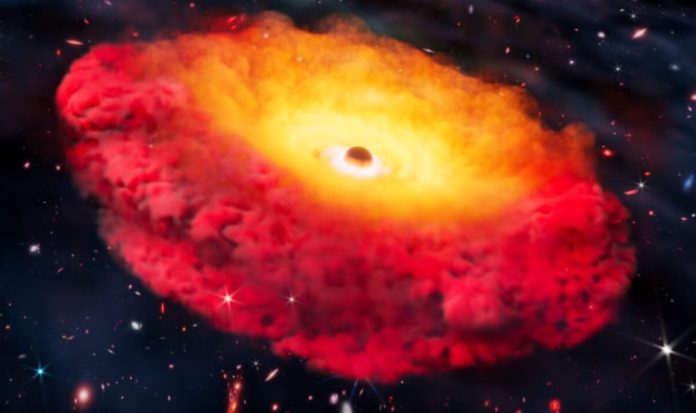
Astronomers have confirmed the most distant black hole ever discovered, giving us a rare glimpse into the early universe.
This enormous black hole, along with its home galaxy known as CAPERS-LRD-z9, existed just 500 million years after the Big Bang—about 13.3 billion years ago, when the universe was only 3% of its current age.
The discovery was made by an international team led by The University of Texas at Austin’s Cosmic Frontier Center.
According to lead researcher Anthony Taylor, finding a black hole this far back in time is close to the limit of what current technology can detect.
The team’s results, published on August 6 in Astrophysical Journal Letters, mark a major milestone in understanding how black holes formed and grew in the universe’s earliest days.
Astronomers can identify black holes by looking for a specific light signature created by gas moving at extreme speeds as it orbits and falls into them.
Gas moving toward us shifts into bluer light, while gas moving away shifts into redder light. This combination is rare and distinctive. Using data from the James Webb Space Telescope’s CAPERS program, the team found that CAPERS-LRD-z9 displayed exactly this pattern.
At first, the galaxy appeared as just a tiny red dot in the telescope’s images. But further study revealed it was part of a mysterious group of compact, bright galaxies from the early universe known as “Little Red Dots.”
These galaxies were a surprise to scientists because they are far brighter than expected for their age, when there had not yet been enough time to form so many stars.
One explanation is that the brightness comes from supermassive black holes rather than stars. Black holes shine brilliantly when they feed on nearby gas and dust, heating it to extreme temperatures.
In the case of CAPERS-LRD-z9, the black hole is surrounded by thick clouds of gas, which may also explain the galaxy’s deep red color.
What makes this black hole truly remarkable is its size—it may be up to 300 million times the mass of our Sun. That’s about half the mass of all the stars in its galaxy. Such a giant black hole so soon after the Big Bang challenges current theories. Either these early black holes grew far faster than expected, or they were born much larger than scientists thought possible.
The researchers plan to use JWST for more detailed observations, hoping to better understand how black holes shaped the formation of early galaxies like the Little Red Dots. As Taylor explains, this discovery offers a rare opportunity: “We haven’t been able to study early black hole evolution until recently, and we’re excited to see what we can learn from this unique object.”
Source: University of Texas at Austin.



